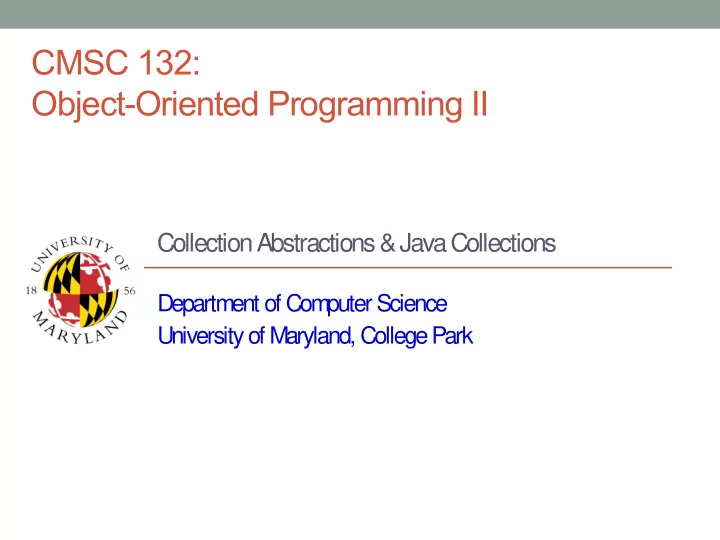

CMSC 132: Object-Oriented Programming II Collection Abstractions & Java Collections Department of Computer Science University of Maryland, College Park
Collection • Programs represent and manipulate abstractions (chunks of information) – Examples: roster of students, deck of cards • One of the most universal abstractions is a collection – Represents an aggregation of multiple objects – Plus, perhaps, a relation between elements – Examples: list, set, ordered set, map, array, tree – Supporting different operations
Data Structures • Data structure – A way of representing & storing information • Choice of data structure affects – Abstractions supported – Amount of storage required – Which operations can be efficiently performed • Collections may be implemented using many different data structures
Graph Abstractions • Many-to-many relationship between elements Each element has multiple predecessors – Each element has multiple successors –
Graph abstractions • Undirected graph Undirected edges – • Directed graph Directed edges – • Directed acyclic graph (DAG) Directed edges, no cycles – Undirected Directed DAG
Tree abstractions • One-to-many relationship between elements Each element has unique predecessor – Each element has multiple successors –
Tree Abstractions • Tree – Only one node (the root) that doesn’t have a parent • Binary Tree – A tree where each node has at most 2 children Tree Binary Tree
Sequence Abstractions • One-to-one relationship between elements – Each element has unique predecessor – Each element has unique successor
Sequences or Ordered Collections • List – A sequence of elements – The user of this interface has precise control over where in the list each element is inserted. – The user can access elements by their integer index (position in the list), and search for elements in the list.
Limited Sequences • Queue – Can add only at the tail – Can only access or remove at the head – First-in, First-out (FIFO) • Stack – Can add only at the top – Can only access or remove at the top – Last-in, First-out (LIFO) • Deque: double ended queue – Can add, access or remove at either end
Set Data Structures • No relationship between elements Elements have no predecessor / successor – Only one copy of element allowed in set – Set A Set B Set C
AbstractionTaxonomy • Classification scheme for data structures – Based on relationships between element • Category Relationship many ⇒ many – Graph one ⇒ many – Hierarchical one ⇒ one – Linear – Set no explicit relationship
Desert Island Abstraction • If you could have only one abstraction with you on a desert island… • Graph is the most general – Can represent any of the other abstractions ● E.g., A set is a graph with no edges • But more specific abstractions have advantages – Some things are unique and well defined (e.g., first element) – Implementations for more specific abstractions can support more efficient operations
Java Collection Framework (JCF) • Java provides several interfaces and classes for manipulating & organizing data – Example: List, Set, Map interfaces • Java Collection Framework consists of – Interfaces ● Abstract data types – Implementations ● Reusable data structures – Algorithms ● Reusable functionality
Collection Hierarchy Interface (red) Class (black)
Collection Interface • http://docs.oracle.com/javase/7/docs/api/java/util/Collection.html • Core operations Add element – – Remove element Determine size (# of elements) – Iterate through all elements – • Additional operations supported by some collections Find first element – Find kth element – Find largest element – Sort elements – • Collection vs. Collections – Collections is a class
Recommend
More recommend